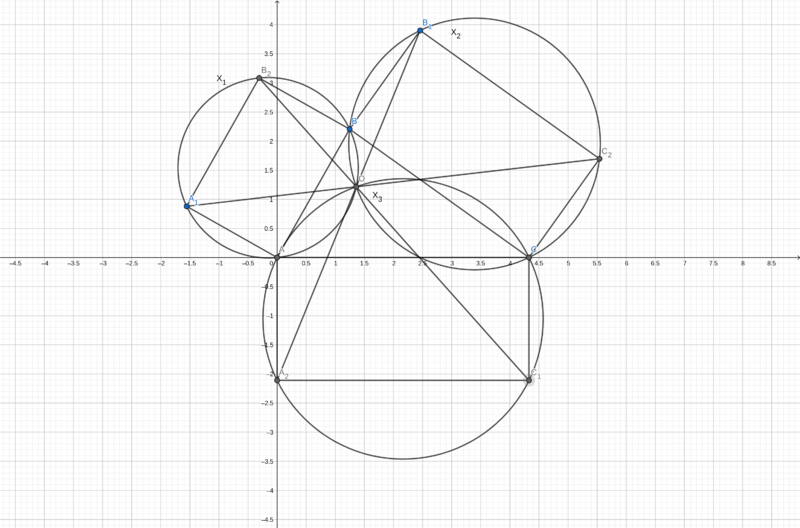Difference between revisions of "Talk:2021 USAMO Problems/Problem 1"
(Some ideas on this problem) |
m (Latex formating fix) |
||
| (8 intermediate revisions by the same user not shown) | |||
| Line 1: | Line 1: | ||
| − | + | We are given the acute triangle <math>ABC</math>, rectangles <math>AA_1B_2B, BB_1C_2C, CC_1A_2A</math> such that <math>\angle AA_1B + \angle BB_1C + \angle CC_1A = \pi</math>. Let's call <math>\angle AA_1B = \alpha, \angle BB_1C = \beta, \angle CC_1A = \gamma</math>. | |
| − | + | Construct circumcircles <math>X_1, X_2</math> around the rectangles <math>AA_1B_2B, BB_1C_2C</math> respectively. <math>X_1, X_2</math> intersect at two points: <math>B</math> and a second point we will label <math>O</math>. Now <math>A_1B</math> is a diameter of <math>X_1</math>, and <math>C_2B</math> is a diameter of <math>X_2</math>, so <math>\angle A_1OB = \angle C_2OB = \frac{\pi}{2}</math>, and <math>\angle A_1OC_2 = \pi</math>, so <math>O</math> is on the diagonal <math>A_1C_2</math>. | |
| − | + | <math>\angle A_1BB_2 = \angle A_1OB_2 = \alpha</math> (angles standing on the same arc of the circle <math>X1</math>), and similarly, <math>\angle B_1BC_2 = \angle B_1OC_2 = \beta</math>. Therefore, <math>\angle B_2OB_1 = \pi - (\alpha + \beta) = \gamma</math>. | |
| + | |||
| + | Construct another circumcircle <math>X_3</math> around the triangle <math>AOC</math>, which intersects <math>AA_2</math> in <math>A'</math>, and <math>CC_1</math> in <math>C'</math>. We will prove that <math>A'=A_2, C'=C_1</math>. Note that <math>A'AOC</math> is a cyclic quadrilateral in <math>X_3</math>, so since <math>\angle A'AC = \frac{\pi}{2}</math>, <math>A'C</math> is a diameter of <math>X_3</math> and <math>\angle A'OC = \angle A'C'C = \frac{\pi}{2}</math> - so <math>A'ACC'</math> is a rectangle. | ||
| + | |||
| + | Since <math>\angle A'AC = \frac{\pi}{2}</math>, <math>A'C</math> is a diameter of <math>X_3</math>, and <math>\angle A'OC = \frac{\pi}{2}</math>. Similarly, <math>\angle B_1OC = \angle C'OA = \angle B_2OA = \frac{\pi}{2}</math>, so O is on <math>B_2C', B_1A'</math>, and by opposite angles, <math>\angle A'OC' = \gamma = \angle A'CC'</math>. | ||
| + | |||
| + | Finally, since <math>A'</math> is on <math>AA_2</math> and <math>C'</math> is on <math>CC_2</math>, that gives <math>\angle A_2AC' = \angle A_2CC_1</math> - meaning <math>C'</math> is on the line <math>AC_1</math>. But <math>C'</math> is also on the line <math>CC_1</math> - so <math>C'=C_1</math>. Similarly, <math>A'=A_2</math>. So the three diagonals <math>A_1C_2, B_1A_2, C_1B_2</math> intersect in <math>O</math>. | ||
| + | |||
| + | [[File:USAMO_Q1.png|alt="USAMO Q1 graph"|800px|USAMO 2021 Q1 set-up]] | ||
Latest revision as of 13:14, 15 September 2021
We are given the acute triangle ![]() , rectangles
, rectangles ![]() such that
such that ![]() . Let's call
. Let's call ![]() .
.
Construct circumcircles ![]() around the rectangles
around the rectangles ![]() respectively.
respectively. ![]() intersect at two points:
intersect at two points: ![]() and a second point we will label
and a second point we will label ![]() . Now
. Now ![]() is a diameter of
is a diameter of ![]() , and
, and ![]() is a diameter of
is a diameter of ![]() , so
, so ![]() , and
, and ![]() , so
, so ![]() is on the diagonal
is on the diagonal ![]() .
.
![]() (angles standing on the same arc of the circle
(angles standing on the same arc of the circle ![]() ), and similarly,
), and similarly, ![]() . Therefore,
. Therefore, ![]() .
.
Construct another circumcircle ![]() around the triangle
around the triangle ![]() , which intersects
, which intersects ![]() in
in ![]() , and
, and ![]() in
in ![]() . We will prove that
. We will prove that ![]() . Note that
. Note that ![]() is a cyclic quadrilateral in
is a cyclic quadrilateral in ![]() , so since
, so since ![]() ,
, ![]() is a diameter of
is a diameter of ![]() and
and ![]() - so
- so ![]() is a rectangle.
is a rectangle.
Since ![]() ,
, ![]() is a diameter of
is a diameter of ![]() , and
, and ![]() . Similarly,
. Similarly, ![]() , so O is on
, so O is on ![]() , and by opposite angles,
, and by opposite angles, ![]() .
.
Finally, since ![]() is on
is on ![]() and
and ![]() is on
is on ![]() , that gives
, that gives ![]() - meaning
- meaning ![]() is on the line
is on the line ![]() . But
. But ![]() is also on the line
is also on the line ![]() - so
- so ![]() . Similarly,
. Similarly, ![]() . So the three diagonals
. So the three diagonals ![]() intersect in
intersect in ![]() .
.










